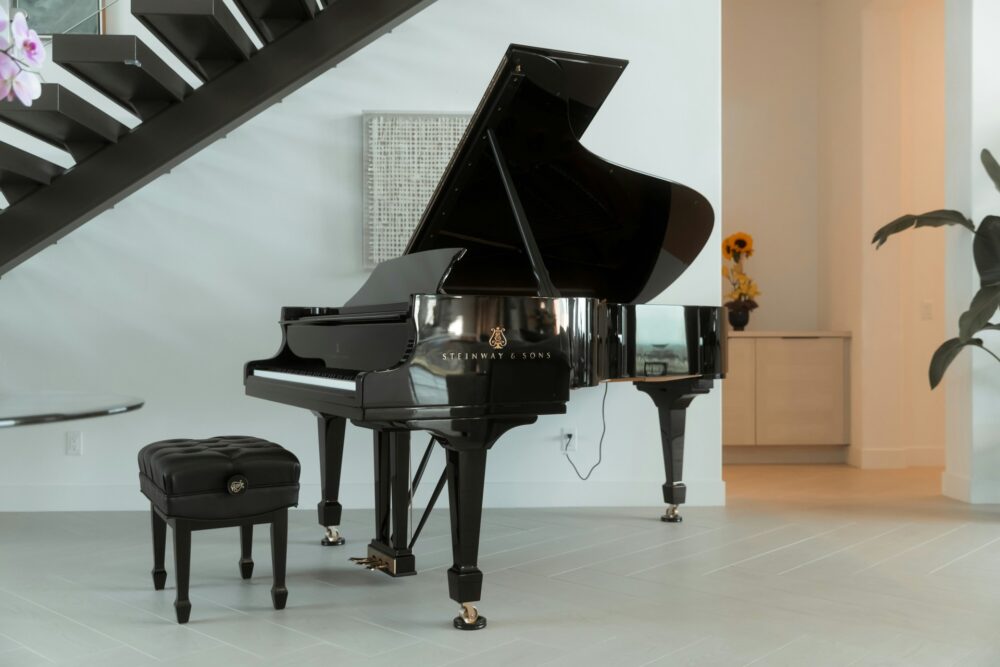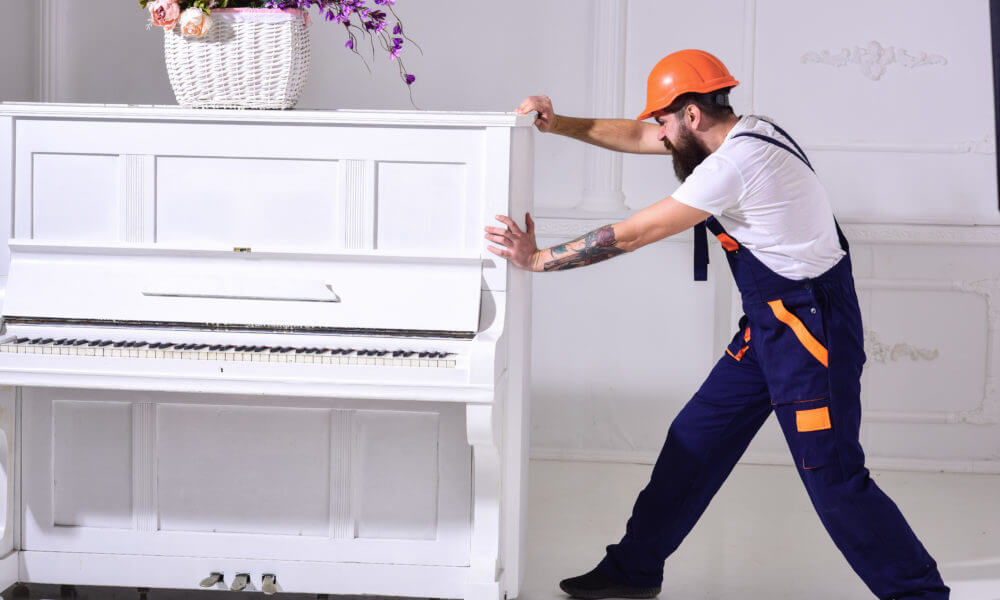Many people have, over the years, became DIY relocation experts. There are tons of tips and hacks for every part of a home. Still, some items are more challenging to move than the others, and none is more so than the king of musical instruments. Ever wondered how to move a piano on your own? If yes, you’re in the right place.

Here we will list all the moving tips concerning the truly delicate art of relocation of pianos. Still, a word of caution is necessary: all tips aside, it is best left to experienced movers. Pianos are so heavy and complex there are shipping companies that specialize in relocating them. One wrong step with such an object could spell irreparable damage to what is probably the most valuable item in the household. Not to mention potential injuries to you or your enlisted helpers. So consider your options carefully.
However, even with all hazards involved, it can still be done, so let’s get on with the guide.
Preparatory Steps
Anyone who has ever handled relocations surely knows the value and importance of proper, old-fashioned planning and preparing. Do that part of the moving to-do list correctly, and you’ll find that much of the famed moving stress has somehow disappeared.
It’s no different when you have to move a large, oddly-shaped, and delicate instrument. Inside pianos, especially grand ones, there are thousands of small parts that all have to be perfectly in place for the instrument to work properly. Mess it up, and you’re in for steep repairs if any are at all possible.
Get Proper Equipment for Moving Pianos
First of all, you’ll need adequate equipment for packing and moving the piano. If everything is to go smoothly, you should get a dolly of adequate size (for the upright instrument) or an item known as a skid board (for grands and baby grands). You’ll also need blankets and towels to wrap the instrument up and secure it from dents, and straps to keep it in place on a dolly, board, and in the truck. Of course, to get the instrument into the truck’s cargo hold, you must have a ramp.
Dollies, ramps, and straps can be acquired from professional movers, as well as in specialized stores.
Don’t Forget to Measure and Plan
When relocating a big instrument, there’s no room for improvisation. So make good use of your time and measure. Indeed, it is one of the commonly forgotten moving hacks that can mean a lot when the time comes for lifting and carrying.
So make a detailed measurement of the path the instrument will take to the truck. Measure every room, doorway, and pathway along the way. It would really be a drag if you found out too late that it is impossible to pass around that last corner. You should also take into account all other furniture, rugs, flowerpots, and decorations that can prove to be an obstacle, or even a distraction, at the worst possible moment. You’ll do well to remove all such objects.
We can not emphasize enough how difficult it is to handle a grand instrument. You and those who help you will require all the attention, concentration, and balance that you can muster. Accidentally kicking a vase while holding onto dozens, if not hundreds of pounds could have detrimental effects on focus and balance. Also, if there is a staircase that has to be scaled, dimensions of steps can be of crucial importance for the entire endeavor.
A final note here is on one unique and different kind of potential obstacles, namely kids and animals. In case you have children and/or are moving with pets, they should not be around when the whole thing is taking place. Both tend to seek attention, and we already said that attention has to be undivided.
Get Some Help
If you decide against hiring professional movers, you’ll have to get help from someone else. The natural persons to turn to are your friends and maybe even some family members. It would be best to enroll at least four persons to lift, carry, and navigate the instrument from your home to the truck. So it is recommended that you choose physically stronger individuals.
So talk to your friends and present them the ins and outs of the task at hand. There will undoubtedly be more than a few ready and willing to aid. You can even throw a moving away party to further sweeten the deal.

How to Move a Piano – The Upright Type
That’s it about the prepping. Now we’ll move on to the tips on moving an upright piano safely.
The first step is to secure the instrument. Lock the keyboard, wrap the instrument in blankets from all sides, and apply tape to hold everything in place. When wrapping, give special protection to the pedals, which are among the most sensitive parts.
Once padded and cushioned, the instrument can be lifted and put on a dolly. At least two people should do the lifting, and with adequate lifting technique, if back injuries are to be avoided. Once the instrument is up, one helper should position the dolly beneath it. Meanwhile, other movers should stand on the sides and provide balance if necessary. When set on wheels, it should be secured for the push to the truck. Of course, you can switch steps and cushion the instrument after you set it on wheels.
If there are stairs along the way, you’ll have to employ more people to hold the item and keep it from falling. One or two steps shouldn’t be that much of a problem for you and your friends. Longer flights should definitely be left to professionals.

Fantastic Tips on How to Move a Baby Grand Piano
If uprights seem complicated to move, then grand ones may well look impossible. We strongly recommend leaving the relocation of a grand, be it baby or concert grand, to a specialized and experienced crew. Unlike its cousin, which, in ideal circumstances can be moved by two or three persons, the grand will require more manpower and much bigger precision in handling. However, if you’re still bent on a DIY relocation, here’s how to do it.
Necessary Steps in How to Move a Piano
There are a couple of significant problems with moving a baby grand. For starters, it’s an extremely heavy object. Much heavier than uprights. Even more, thanks to its shape, distributing weight evenly is next to impossible. Then there’s the matter of the instrument’s integrity, with thousands of small and delicate parts within the piano’s mechanism.
So, again, it’s all about securing the instrument before putting it on a skid board, as dollies aren’t of much use with them. The first thing to do is to secure the top lid and the keys. This can easily be done with tape. Next comes partial disassembling. You or one of your friends should crawl under the instrument and remove one of the front corner legs, while all others hold the whole thing, keeping it from falling and relieving the pressure from remaining legs. Then it’s time to lower it on its longer, left side and placed on a padded skid board.
Once on the board, the instrument should be wrapped up in blankets, secured with straps, and remaining legs taken apart, as well as pedals. It goes without saying that they are to be cushioned in blankets, too.
Finally, after tips on what to do comes one of caution. The thing that is never to be attempted is rolling the instrument. Yes, many of them have wheels attached to the legs, but they are not meant for long rolls. If you try it, there’s a high probability of the legs breaking, or the wheels jamming and wreaking havoc on carpets or floors. We wouldn’t want that, and we’re sure you don’t either.
Protect the Instrument But Don’t Neglect Safety
As we said, a piano is probably the most valuable item in every household that owns one. It is, therefore, understandable that you would go great lengths to protect it. But some things are even more precious – the health and well-being of you and friends who help you. We’re sure you’d rather come out of the task with a beer with dear people than in the ER.
So make preparations for your movers as well. Besides learning about lifting techniques, you should get a couple of sturdy shoulder harnesses. Those items won’t give additional carrying capacity to the lifters but will be a great aid in keeping their bodies a bit further from harm. And by protecting the lifters, harnesses will protect the instrument, too.
In the Truck and Afterwards
Once the instrument has left the home, it’s time to get it in a truck. So push it up the ramp and then all the way to the back of the cargo hold. This is a must for every relocation, be it local moving or not, since it will be least likely to fall over. To lessen the odds even more, you should use straps and harnesses to secure it in place safely.
At the destination, the process will be more or less the same, only reversed. Your new home should be measured from top to bottom as well. In case of long-distance moving, you may have to hire local movers to carry the instrument inside (unless, of course, you take your friends on a cross-country road trip). And when you’re settled, all that’s left is to tune the piano and start making friends in a new city.

How Much Does It Cost to Move a Piano
The price the professionals charge for the service varies depending on the instrument type. Other factors that affect the price are the number of men required for the task, the length of the carry, relocation distance, or whether there’s a staircase to be scaled. All in all, many shipping companies will include instruments in their quote. If we’re talking about exact numbers, it can go from a couple of hundreds to more than a thousand dollars.
One more financial aspect that should always be a part of cost calculations is moving insurance. You can buy a policy from a shipping company or some other insurer.

Relocating Pianos is Best Left to Professionals
So there you have it – all the basics you need to know on the matter. Still, to paraphrase dr. Ian Malcolm, before thinking whether you can move an instrument by yourself, think about whether you should do it.
Yes, the costs of this endeavor can add up quite a bit on your moving expenses checklist, and you can save money by going DIY. But by doing so, you’re risking your well-being, your household, and the instrument itself. Shipping companies will send experts who can lift, carry, and do the packing in a relatively short time. Also, they may even offer you a certain period of free storage services.
So, going forward with professionals may not be the cheapest way to move out of state with a valuable musical instrument, but it would definitely save you loads of time, strength, and nerves for packing of other stuff.





